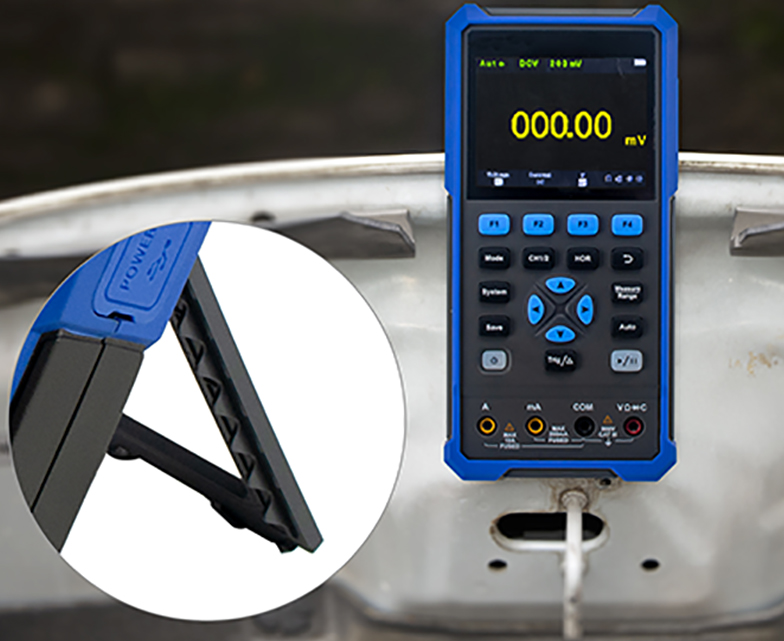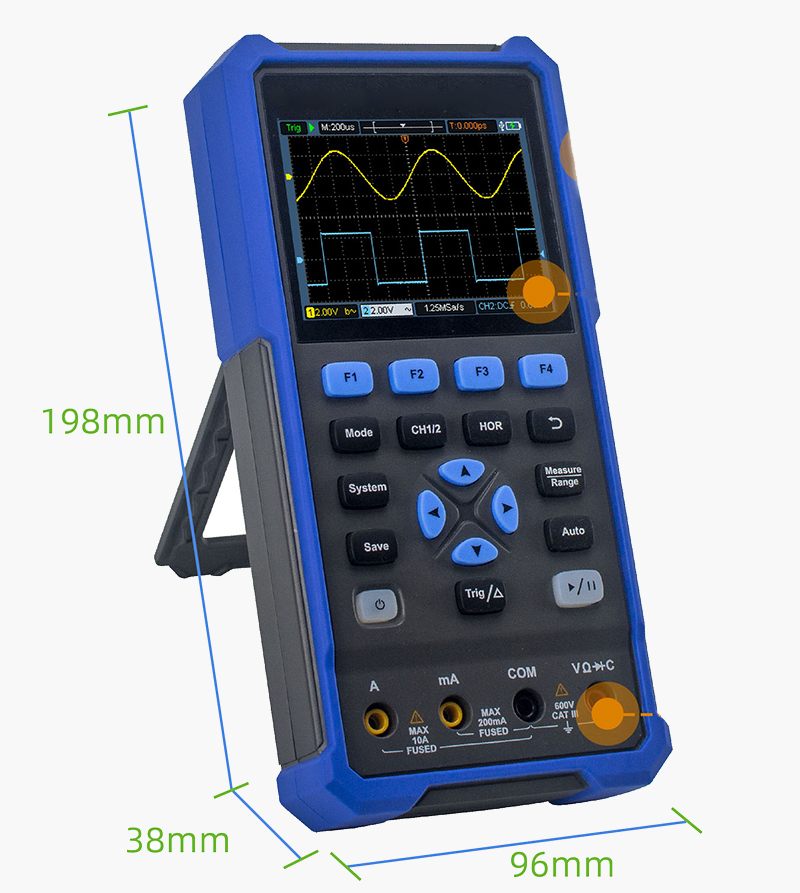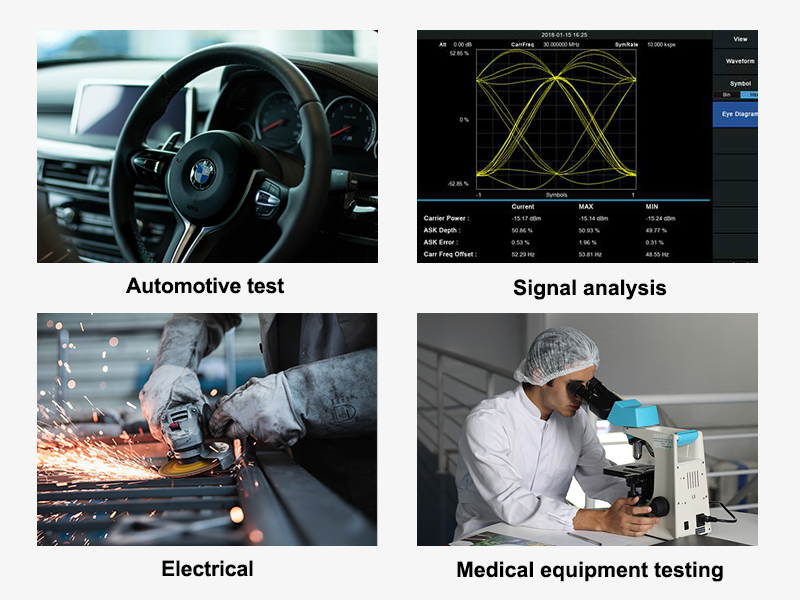200 MHz 2-channel handheld digital oscilloscope with 1 GSa/s sample rate, max. waveform capture rate up to 10,000 wfms/s. Mobile phone body, oscilloscope, and digital multimeter multifunction in one. 3.5-inch high-resolution, high-contrast color LCD display, suitable for outdoor use.

USB Type-charging design
- USB Type-charging interface, which can be adapted to chargers or charging treasures.
- Support host computer connection can save waveform pictures and data.

Bracket design
- 3.5-inch high-resolution, high-contrast color LCD display,can work continuously for about 6 hours.
- Suspended stand to save workspace.
Dimension Unit (mm)

Application
The main application of a SISCO oscilloscope is used to display the waveforms of signals. It can be used in many fields such as automotive test, signal analysis, electrical, transducer test and measurement, electrical equipment design, medical equipment testing field, etc.

Performance Characteristics
| Model | SISCO-HDS2202 |
| Bandwidth | 200MHz |
| Channel | 2 channel |
| Sample rate | 1 GSa/s |
| Acquisition model | Sample, Peak detect |
| Record length | 6K |
| Display | 3.5 inch LCD |
| Waveform refresh rate | 10000 wfrms/s |
| Input coupling | DC, AC, Ground |
| Input impedance | 1 MΩ±2%, in parallel with 16 pF±10 pF |
| Probe attenuation | 1X,10X,100X,1000X |
| Max. input voltage | 400V (DC+AC, PK - PK) |
| Bandwidth limit(typical) | 20MHz/ Full bandwidth |
| Sampling rate range |
2ns/div - 1000s/div, step by 1- 2- 5 |
| Sensitivity Resolution | 10mV/div~10V/div |
| Low Frequency(-3db) | ≥10 Hz (at input, AC coupling) |
| Rise time (at input, Typical) | ≤8ns |
| Trigger type | Edge |
| Trigger model | Auto, Normal, single |
| Trigger level range | ±4 div from the screen center |
| Automatic measurement | Period, Frequency, Mean, PK-PK, Max, Min |
| Cursor measurement | ΔV, ΔT, ΔT&ΔV between cursors,auto cursor |
| Communication interface | USB Type-C |
Digital Multimeter Specification
| Full-scale reading | 4.5 digitals (max 20000 count) |
| Testing Modes |
Voltage, Current, Resistance, Capacitance, Diode, Continuity |
| Maximum Input Voltage | AC 750V, DC 1000V |
| Maximum Input Current | DC: 10A, AC: 10A |
| Diodes Test | 0-2V |
Accessories
- Quick Guide
- USB Cable
- Probe
- Probe Adjust
- Multimeter
- Lead
- BNC plug to alligator clips cable
- Soft Bag
Q1: Can an oscilloscope measure DC voltage?
A1: DC voltage can be measured using either an oscilloscope or a digital multimeter. Each piece of testing equipment has its advantages and disadvantages.
Q2: What is the maximum frequency for the oscilloscope?
A2: System bandwidth determines an oscilloscope's fundamental ability to measure an analog signal - the maximum frequency range that it can accurately measure. Entry-level scopes will often have a maximum bandwidth of 100 MHz. They can accurately (within 2%) show the amplitudes of sine-wave signals up to 20 MHz.
Q3: What is the record length for an oscilloscope?
A3: The record length, measured in points or samples, divided by the sample rate (in Samples/second) specifies the total time (in seconds) that is acquired. Example: With a record length of 1 M points and a sample rate of 250 MSa/sec, the oscilloscope will capture a signal of 4 msec in length.
Tips: Handheld oscilloscope troubleshooting
- The oscilloscope does not start: It may be that the battery power has been completely depleted. At this time, even if powered by the power adapter, the oscilloscope still can not start. First need to charge the battery, do not turn on the oscilloscope first. Wait for about 15 minutes, then try to open the oscilloscope.
- The oscilloscope will turn off after a few seconds of starting: The battery may have run out of power. Check the battery symbol at the top left of the screen. The symbol indicates that the battery is depleted and must be recharged.
- Switch to the multimeter and the measurement type displays E: It is possible that the measurement type is not selected, in this case, press the F4 key, the measurement type should display the corresponding measurement type. Press F4 to display the corresponding measurement type. If E is still displayed, restart the oscilloscope.
- The measured voltage amplitude value is 10 times larger or smaller than the actual value in the oscilloscope state: Check that the channel attenuation coefficient matches the actual probe error ratio used.
Thank you for buying industrial test and measurement equipment on SISCO.com, all products sold by SISCO and the partner cover a 12 months warranty, effective from the date of receiving the products.
What is covered?
SISCO is responsible for providing free spare parts, and free technical support to assist the customer to repair the defective products until the problem is solved.
What is not covered?
- Product purchased from anyone other than a SISCO store or a SISCO authorized reseller.
- Expendable parts.
- Routine cleaning or normal cosmetic and mechanical wear.
- Damage from misuse, abuse or neglect.
- Damage from use of parts other than SISCO approved.
- Damage from use outside the product’s usage or storage parameters.
- Damage from use of parts not sold by SISCO.
- Damage from modification or incorporation into other products.
- Damage from repair or replacement of warranted parts by a service provider other than a SISCO authorized service provider.
- Damage caused by the application environment not meeting the product usage requirements and the failure to perform preventive maintenance.

